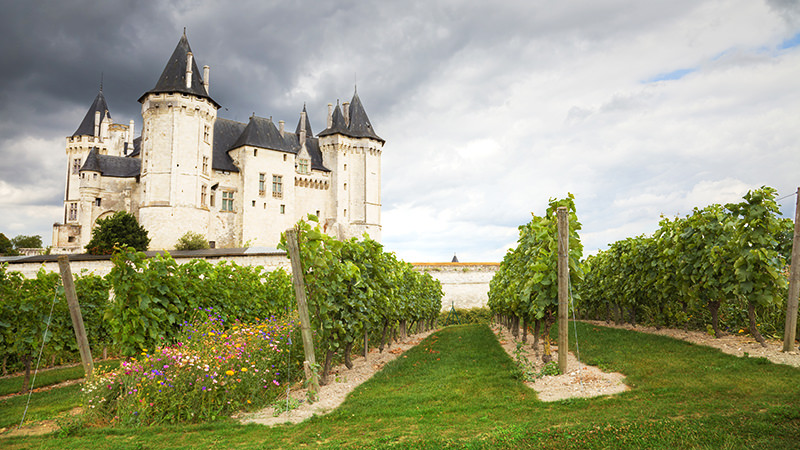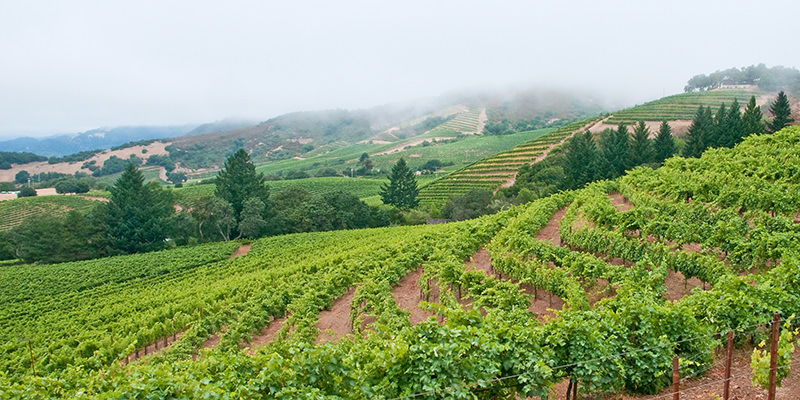Here’s a radical idea: the most important thing that impacts a wine’s flavor profile isn’t the grape it’s made from. It isn’t even the winemaking style. It’s the climate. Take, as an example, Chardonnay. If you compare a rich, ripe, Napa Valley Chardonnay to a bright, tart, and lithe Chardonnay from Burgundy, in France, you might wonder if these wines are actually made from the same grape at all.
The nuances of climate are multifold (particularly because vintage variation can cause freak high and low temperatures) but a good place to start understanding it is with the concept of “cool-climate wine.” We all have this image in our minds of a sun-drenched vineyard with shiny, ready-to-burst grapes and verdant green canopies. And yes, during the growing season for grapes, sunshine is very important—as it allows grapes to develop sugar, which they then convert into potential alcohol.
But equally as important is the opposite of sunshine—coolness. For many grape varieties, the ideal growing region is one that has significant “diurnal shifts,” meaning there is a big drop in temperature from daytime to nighttime. Low evening temperatures help preserve malic acid in the grape, which ideally would lead to overall, balanced acidity in the finished wine. (Malic acid is that lemony aspect of white wine that makes you smack your lips.) High altitude wine regions (or, specific high elevation vineyard sites) experience the greatest diurnal shifts; maritime influence can also contribute to nighttime cooling.
Some regions, like the Loire Valley in the north of France, are just inherently cool, so the grapes don’t ripen as much—which results in low-alcohol, high-acid wines across the board. So, if you’re craving a silky, chocolately Cabernet, this kind of wine might be a bit abrasive, or perhaps it simply won’t be your thing. But when paired with light foods or cheeses, cool climate wines strike a nice balance of subtlety, flavor, and earthiness. They are often ideal in the summertime, when you can pop them in the fridge to get a nice chill. You’ll appreciate their freshness at a barbecue. And, the nice thing about low-alcohol wines, besides their overall mineral flavor profile, is that you can drink more without getting quite as drunk.
Below are some cool climate wine regions to explore when your palate is craving some acidity and minerality, or simply for the sake of comparing different expressions of your favorite grape.
Sonoma Valley, CA
Generally speaking, California is a fairly hot grape growing region. But many of Sonoma Valley’s vineyards are planted either near the coast or amongst the slopes and peaks of the Mayacamas mountains, although some AVAs (American Viticultural Area—our version of appellations) within the region are warmer. The Pacific Ocean offers an overall cooling effect that keeps Sonoma’s grapes from ripening as much as their neighboring appellation, the Napa Valley. As well, the fog rolling through the hills from the Russian River helps balance out warm, sunny days. To sample cool climate Sonoma, look for bottles from Carneros (typically Pinot Noir and Chardonnay), Russian River Valley, Bennett Valley, and high elevation vineyards in the Anderson Valley in Mendocino.
Finger Lakes, NY
Situated in Upstate New York around a group of seven lakes, this region is so cool that people once doubted the possibility of growing European wine grapes there. But one Ukrainian immigrant, who arrived with a PhD in viticulture, was determined to prove them wrong. Dr. Konstantin Frank worked alongside a Champagne maker named Charles Fournier to get Riesling to grow, and the two finally made it happen; today the winery that Frank founded is run by his great-granddaughter Meaghan Frank. These days, it’s not only top-notch dry Riesling that flourishes amongst the many small growers and winery owners in the Finger Lakes, but also Pinot Noir, Chardonnay, and other varieties.

Loire Valley, France
Temperatures are so low in this northern French region, named for the long river running through it, and located just to the west of Paris and butting up against the Atlantic, that it can be difficult for red grapes to ripen fully. That means that Loire reds, most commonly made from Gamay or Cabernet Franc, are some of the lightest, freshest, and lowest in alcohol out there. In terms of whites, there are beautiful, high-acid Chenin Blanc wines, most notably from Vouvray as well as Montlouis, and there are champagne method sparkling Vouvrays, too. Perhaps the most well-known Loire white is Sancerre, the wine made from Sauvignon Blanc grown on oyster-rich, Kimmeridgian soil—but don’t miss out on the high-acid splendor of Muscadet, a much more affordable but equally delicious white wine from vineyards along the Atlantic coast. Loire rosés, typically made from Gamay or Cabernet Franc, are also steeling and bright.
Champagne, France
One of the ideal wines to make in a cool climate region is bubbly. Since a sparkling wine is supposed to be light on its feet, acidity is very important. Although there is some red wine and still rosé made in the Champagne region of France, of course its signature product is that wonderful, tart, traditionally made sparkling wine that we love popping on special occasions. Although, if you ask me, Champagne is a great food wine to be enjoyed on any day that you’re in the mood for something delicious, rather than reserved only for holidays! (For more about cool climate sparkling wine, check out the American bubbly producer Gruet, made from high elevation vineyards in New Mexico.)
Northern Italy
Quite often, the Italian red people grab instinctively is full-bodied Chianti, from the Tuscany region. But up in the north, where the Alps provide those desirable diurnal shifts, you get light and mineral reds made from Nebbiolo, Barbera, and even some Gamay, all in the Western regions, and indigenous varieties Teroldego and Lagrein, in the Eastern parts. In terms of whites, there’s Gavi di Gavi from Piedmont, made from the Cortese grape, which can be somewhat round but generally retains acidity; there’s also some very nice, fairly dry Gewürztraminer wine in Alto Adige, and a deep tradition of high-quality Pinot Grigio in Friuli. And Northern Italy produces a wonderful, champagne-method sparkling wine called Franciacorta that benefits from the Alpine influence as well.
Willamette Valley, OR
The reason people decided that central Oregon was fit for growing Pinot Noir and Chardonnay back in the 1960s, when vineyards were first planted there, is that the climate reminded them of the foggy, rolling hills of Burgundy, the French region where these grapes are historically grown. There are six AVAs within the Willamette Valley, so much like Sonoma it is difficult to fully generalize about the region—but overall, there is coolness present thanks to the Willamette River and the Pacific Ocean. Today, Pinot Noir is definitely still king in Oregon, although there is also beautiful high-elevation Syrah being made, and nice dry Pinot Gris, too.

